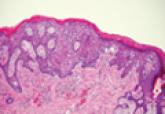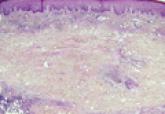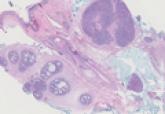Dermpath Diagnosis

Extramammary Paget Disease
Extramammary Paget disease (EMPD) is an uncommon condition that usually presents in apocrine sweat gland–rich areas, most commonly the vulva...
Alyssa Miceli, DO; Nathan Cleaver, DO; Amy Spizuoco, DO
Dr. Miceli is from the College of Osteopathic Medicine, New York Institute of Technology, Old Westbury. Drs. Cleaver and Spizuoco are from Ackerman Academy of Dermatopathology, New York, New York.
The authors report no conflict of interest.
Correspondence: Amy Spizuoco, DO, Ackerman Academy of Dermatopathology, 145 E 32nd Street, 10th Floor, New York, NY 10016
(alspiz@yahoo.com).

Rosai-Dorfman disease, also known as sinus histiocytosis with massive lymphade-nopathy, is a rare benign histioproliferative disorder of unknown etiology. Clinically, it is most frequently characterized by massive painless cervical lymphadenopathy with other systemic manifestations, including fever, night sweats, and weight loss. Accompanying laboratory findings include leukocytosis with neutrophilia, elevated erythrocyte sedimentation rate, and polyclonal hypergammaglobulinemia.
The differential diagnosis for Rosai-Dorfman disease includes eruptive xanthoma, juvenile xanthogranuloma, Langerhans cell histiocytosis, and reticulohistiocytoma.
Rosai-Dorfman disease (RDD), also known as sinus histiocytosis with massive lymphadenopathy, is a rare benign histioproliferative disorder of unknown etiology.1 Clinically, it is most frequently characterized by massive painless cervical lymphadenopathy with other systemic manifestations, including fever, night sweats, and weight loss. Accompanying laboratory findings include leukocytosis with neutrophilia, elevated erythrocyte sedimentation rate, and polyclonal hypergammaglobulinemia. Extranodal involvement has been noted in more than 40% of cases, and cutaneous lesions represent the most common form of extranodal disease.2 Cutaneous RDD is a distinct and rare entity limited to the skin without lymphadenopathy or other extracutaneous involvement.3 Patients with cutaneous RDD typically present with papules and plaques that can grow to form nodules with satellite lesions that resolve into fibrotic plaques before spontaneous regression.4
Histologic examination of cutaneous lesions of RDD reveals a dense nodular dermal and often subcutaneous infiltrate of characteristic large polygonal histiocytes termed Rosai-Dorfman cells, which feature abundant pale to eosinophilic cytoplasm, indistinct borders, and large vesicular nuclei with prominent nucleoli (Figure 1).4,5 Some multinucleate forms may be seen. These Rosai-Dorfman cells display positive staining for CD68 and S-100, and negative staining for CD1a on immunohistochemistry. Lymphocytes and plasma cells often are admixed with the Rosai-Dorfman cells, and neutrophils and eosinophils also may be present in the infiltrate.4 The histologic hallmark of RDD is emperipolesis, a phenomenon whereby inflammatory cells such as lymphocytes and plasma cells reside intact within the cytoplasm of histiocytes (Figure 2).5
| Figure 1. Sheets of large polygonal histiocytes with admixed lymphocytes and plasma cells seen in Rosai-Dorfman disease (H&E, original magnification ×200). | Figure 2. Emperipolesis (histiocyte-engulfing lymphocytes) demonstrated in Rosai-Dorfman disease (H&E, original magnification ×600). |
The histologic differential diagnosis of cutaneous lesions of RDD includes other histiocytic and xanthomatous diseases, including eruptive xanthoma, juvenile xanthogranuloma, Langerhans cell histiocytosis, and solitary reticulohistiocytoma, which should not display emperipolesis. Eruptive xanthomas display collections of foamy histiocytes in the dermis and typically contain extracellular lipid. They may contain infiltrates of lymphocytes (Figure 3). Juvenile xanthogranuloma also features a dense infiltrate of histiocytes in the papillary and reticular dermis but distinctly shows Touton giant cells and lipidization of histiocytes (Figure 4). Both eruptive xanthomas and juvenile xanthogranulomas typically stain negatively for S-100. Langerhans cell histiocytosis is histologically characterized by a dermal infiltrate of Langerhans cells that have their own distinctive morphologic features. They are uniformly ovoid with abundant eosinophilic cytoplasm. Their nuclei are smaller than those of Rosai-Dorfman cells and have a kidney bean shape with inconspicuous nucleoli (Figure 5). Epidermotropism of these cells can be observed. Immunohistochemically, Langerhans cell histiocytosis typically is S-100 positive, CD1a positive, and langerin positive. Reticulohistiocytoma features histiocytes that have a characteristic dusty rose or ground glass cytoplasm with two-toned darker and lighter areas (Figure 6). Reticulohistiocytoma cells stain positively for CD68 but typically stain negatively for both CD1a and S-100.
| Figure 3. Lipid-laden macrophages with foamy cytoplasm and extracellular lipid seen in eruptive xanthoma (H&E, original magnification ×400). | Figure 4. Touton giant cell (wreath of nuclei surrounded by foamy cytoplasm) featured in juvenile xanthogranuloma (H&E, original magnification ×600). | ||
| Figure 5. Dermal infiltrate of ovoid Langerhans cells with reniform nuclei in Langerhans cell histiocytosis (H&E, original magnification ×600). | Figure 6. Histiocytes with dusty rose–colored cytoplasm and admixed lymphocytes in a reticulohistiocytoma (H&E, original magnification ×400). |

Extramammary Paget disease (EMPD) is an uncommon condition that usually presents in apocrine sweat gland–rich areas, most commonly the vulva...

Necrobiosis lipoidica diabeticorum (NLD) is a rare granulomatous skin manifestation that is strongly associated with diabetes mellitus....

The coexistence of more than one cutaneous adnexal neoplasm in a single biopsy specimen is unusual and is most frequently recognized in the...
